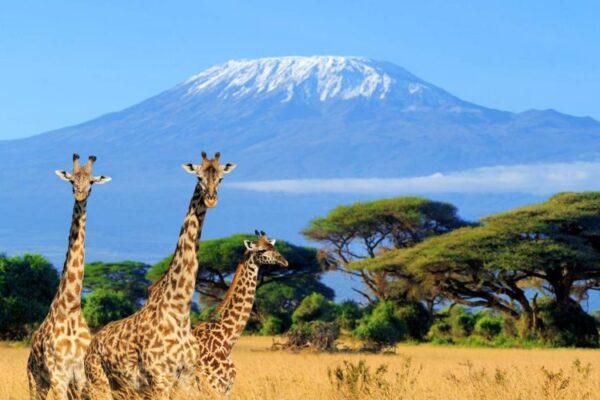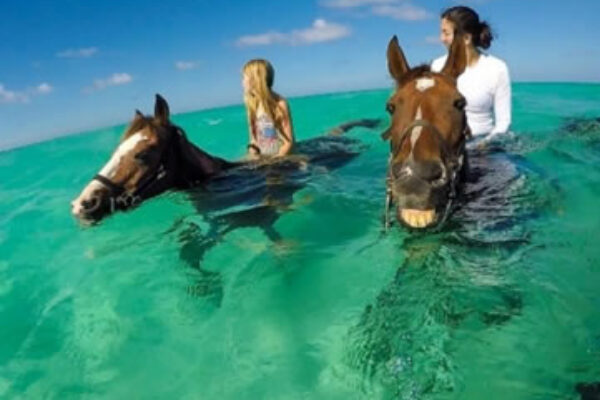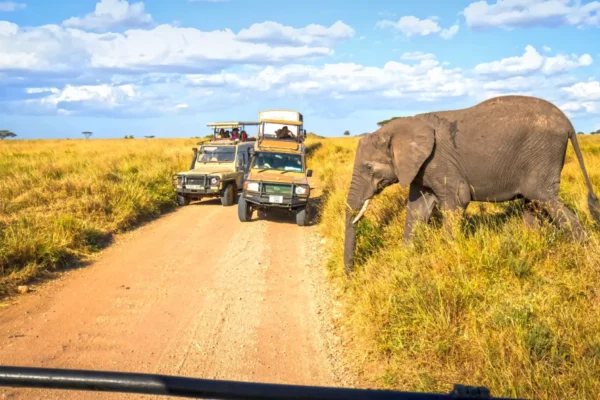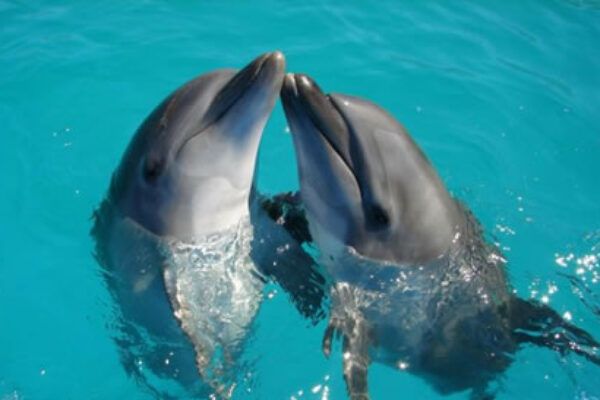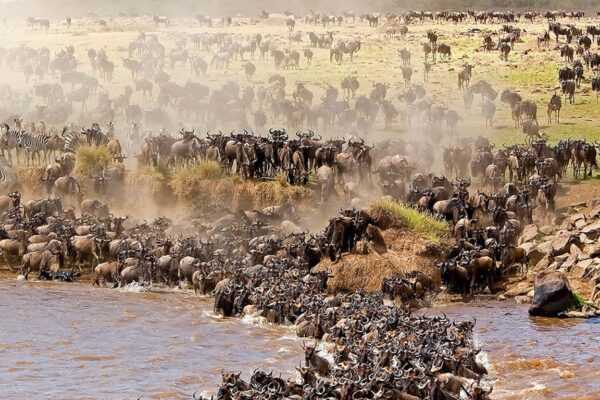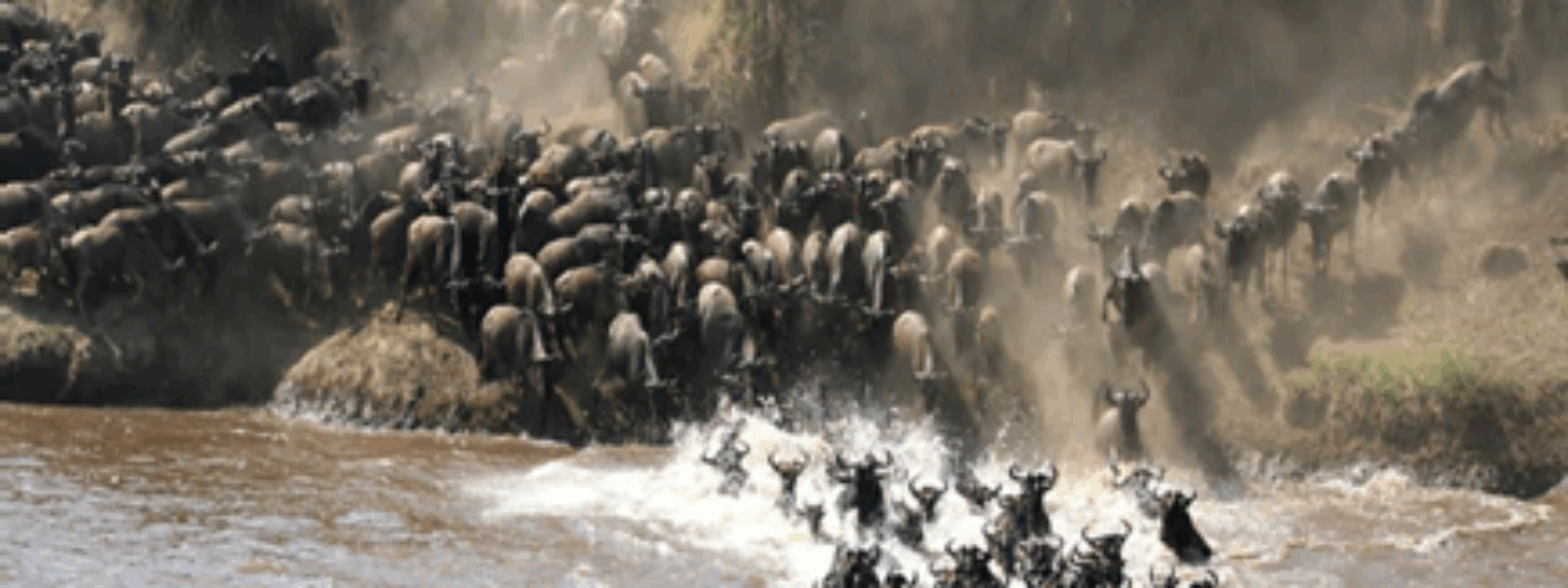
Tanzania
The journey starts in Southern Serengeti when half a million wildebeest calves are being born between January and March. Predators like lions and hyenas are constantly hunting for babies, and thousands and thousands of calves are born within a couple weeks of each other – a feast for the eyes of true wildlife enthusiasts. When the drought comes in May, the roughly two million wildebeest herd moves north, towards the Masai Mara in Kenya, chomping down the high green grass, quickly followed by the gazelles and zebras. The migration is not without risk: crossing rivers means facing about 3,000 crocodiles, patiently waiting for a kill. Not to mention the famous Serengeti lion population: by far the largest in Africa. Despite the abundance of hoofed meat in this area, life is not easy for these big cats in this unforgiving landscape. But seeing a group of lions collaborating to hunt down a wildebeest is an unforgettable sight. Then, with the beginning of the short rains in late October, the migration makes its way back into the Serengeti. By December, the herds trek past Seronera - a small settlement in central Serengeti where the official Serengeti Visitors’ Centre is located - to return to their calving grounds again, and the circle is complete. It is a matter of choice whether you would like to plan your Serengeti safari around the Great Migration. We have mentioned earlier that the Serengeti is a year-round destination as it covers a vast area and offers unparalleled wildlife viewing. Chances that you will be at the exact spot of the Great Migration herd crossing a river (either at the Grumeti or Mara River) are very slim. Also, the timing of herd movements cannot be guaranteed. However, if you choose the right part of the Serengeti: the southeast and Ndutu from December through to May, the Western Corridor from May to July, the Serengeti Mara area from July through to October, and the northern Serengeti and Lobo area in October and November, large herds of wildebeest and their entourage should be easily located. The World's Largest Intact & Unfilled Volcanic Caldera - The Ngorongoro Crater It is the world's largest intact and unfilled volcanic caldera, formed when a giant volcano exploded and collapsed millions of years ago. The Ngorongoro Crater is a UNESCO World Heritage Site and is about 20 kilometres (12.5 miles) wide and 600 meters (2,000 feet) deep. The Ngorongoro Crater has a unique ecosystem due to its fertile volcanic soil and is often referred to as "the Garden of Eden". The crater floor is home to a high concentration of diverse wildlife (over 25, 000) including the "Big Five": elephants, buffaloes, rhinos, lions, and leopards. Other animals found in the crater include hippos, hyenas, warthogs, zebras, elands, gazelles, and wildebeests. The best time to visit the Ngorongoro Crater is during the dry season (June to October), when the grass is short and wildlife viewing is easier. The Highest Mountain in Africa - Mt. Kilimanjaro At 19,340 ft above sea level, Kilimanjaro is the highest mountain in Africa. What's more, because it juts more than 16,000 ft above the surrounding plains, its summit offers one of the most breathtaking sights in the entire world. Ascending Kilimanjaro from mid-December through mid-march or June until October will maximize your chances of an unobscured view. This Tanzanian mountain offers 7 different ascents that require no mountaineering skills. Each offers varying levels of difficulty, quality of scenery, foot traffic and amount of time for altitude acclimation. Because a mountain crew takes care of everything, a climber needs to only focus on summiting. This means you can prioritize acclimating yourself and observing the unique climatic zones and their accompanying flora and fauna. The Paradise Island – Zanzibar Achieve memorable experiences by seeing many beautiful tour destinations in Zanzibar such as prison island tours, stone town tours, safari blue tours, spice tours, dolphin tours, Jozani Forest National Park, Mnemba Island tours, Ngwi Natural Aquarium, etc. involve yourself in unforgettable tour activities of diving and snorkeling, horseback riding, local fishing, skydiving, and many such activities during your Zanzibar day tours journey. Mnemba Island was ranked #1 Best Beach Destination in Africa by trip savvy and is well known for the excellent clarity of its waters ( for this area of the Indian Ocean). Mnemba Island is an atoll set just off the northeast coast near Matemwe. Snorkling at Mnemba is stunning, on the inside it’s like being in a giant aquarium and the outside offers excellent wall and drift dives. The island itself is a breeding ground for turtles and they are often seen gliding by along with dolphins, huge groups of fish, whale sharks and humpbacks when in season.
The journey starts in Southern Serengeti when half a million wildebeest calves are being born between January and March. Predators like lions and hyenas are constantly hunting for babies, and thousands and thousands of calves are born within a couple weeks of each other – a feast for the eyes of true wildlife enthusiasts. When the drought comes in May, the roughly two million wildebeest herd moves north, towards the Masai Mara in Kenya, chomping down the high green grass, quickly followed by the gazelles and zebras. The migration is not without risk: crossing rivers means facing about 3,000 crocodiles, patiently waiting for a kill. Not to mention the famous Serengeti lion population: by far the largest in Africa. Despite the abundance of hoofed meat in this area, life is not easy for these big cats in this unforgiving landscape. But seeing a group of lions collaborating to hunt down a wildebeest is an unforgettable sight. Then, with the beginning of the short rains in late October, the migration makes its way back into the Serengeti. By December, the herds trek past Seronera - a small settlement in central Serengeti where the official Serengeti Visitors’ Centre is located - to return to their calving grounds again, and the circle is complete. It is a matter of choice whether you would like to plan your Serengeti safari around the Great Migration. We have mentioned earlier that the Serengeti is a year-round destination as it covers a vast area and offers unparalleled wildlife viewing. Chances that you will be at the exact spot of the Great Migration herd crossing a river (either at the Grumeti or Mara River) are very slim. Also, the timing of herd movements cannot be guaranteed. However, if you choose the right part of the Serengeti: the southeast and Ndutu from December through to May, the Western Corridor from May to July, the Serengeti Mara area from July through to October, and the northern Serengeti and Lobo area in October and November, large herds of wildebeest and their entourage should be easily located. The World's Largest Intact & Unfilled Volcanic Caldera - The Ngorongoro Crater It is the world's largest intact and unfilled volcanic caldera, formed when a giant volcano exploded and collapsed millions of years ago. The Ngorongoro Crater is a UNESCO World Heritage Site and is about 20 kilometres (12.5 miles) wide and 600 meters (2,000 feet) deep. The Ngorongoro Crater has a unique ecosystem due to its fertile volcanic soil and is often referred to as "the Garden of Eden". The crater floor is home to a high concentration of diverse wildlife (over 25, 000) including the "Big Five": elephants, buffaloes, rhinos, lions, and leopards. Other animals found in the crater include hippos, hyenas, warthogs, zebras, elands, gazelles, and wildebeests. The best time to visit the Ngorongoro Crater is during the dry season (June to October), when the grass is short and wildlife viewing is easier. The Highest Mountain in Africa - Mt. Kilimanjaro At 19,340 ft above sea level, Kilimanjaro is the highest mountain in Africa. What's more, because it juts more than 16,000 ft above the surrounding plains, its summit offers one of the most breathtaking sights in the entire world. Ascending Kilimanjaro from mid-December through mid-march or June until October will maximize your chances of an unobscured view. This Tanzanian mountain offers 7 different ascents that require no mountaineering skills. Each offers varying levels of difficulty, quality of scenery, foot traffic and amount of time for altitude acclimation. Because a mountain crew takes care of everything, a climber needs to only focus on summiting. This means you can prioritize acclimating yourself and observing the unique climatic zones and their accompanying flora and fauna. The Paradise Island – Zanzibar Achieve memorable experiences by seeing many beautiful tour destinations in Zanzibar such as prison island tours, stone town tours, safari blue tours, spice tours, dolphin tours, Jozani Forest National Park, Mnemba Island tours, Ngwi Natural Aquarium, etc. involve yourself in unforgettable tour activities of diving and snorkeling, horseback riding, local fishing, skydiving, and many such activities during your Zanzibar day tours journey. Mnemba Island was ranked #1 Best Beach Destination in Africa by trip savvy and is well known for the excellent clarity of its waters ( for this area of the Indian Ocean). Mnemba Island is an atoll set just off the northeast coast near Matemwe. Snorkling at Mnemba is stunning, on the inside it’s like being in a giant aquarium and the outside offers excellent wall and drift dives. The island itself is a breeding ground for turtles and they are often seen gliding by along with dolphins, huge groups of fish, whale sharks and humpbacks when in season.
5 tours in Tanzania
Login to use
Login to use
Login to use
Login to use
Showing 1 – 5 of 5 tours found
FAQ’s about Tanzania
Have more questions? Contact us.
What animals can I see in Tanzania?
Where is Tanzania located?
How many national parks are there in Tanzania?
What can I do in Tanzania besides going on safari?
What should I wear on a Tanzanian safari?
Where do I fly into Tanzania for a safari?
What is Tanzania’s national animal?
Do I need a visa to visit Tanzania?
What vaccines do I need to visit Tanzania?
Is Tanzania malaria free?
No. Over 93% of the population in mainland Tanzania live in malaria transmission areas. We advise all our guests to chat to their physician about the best anti-malaria medicine to take. Please note, many anti-malaria tablets need to be taken a few weeks before departure.

